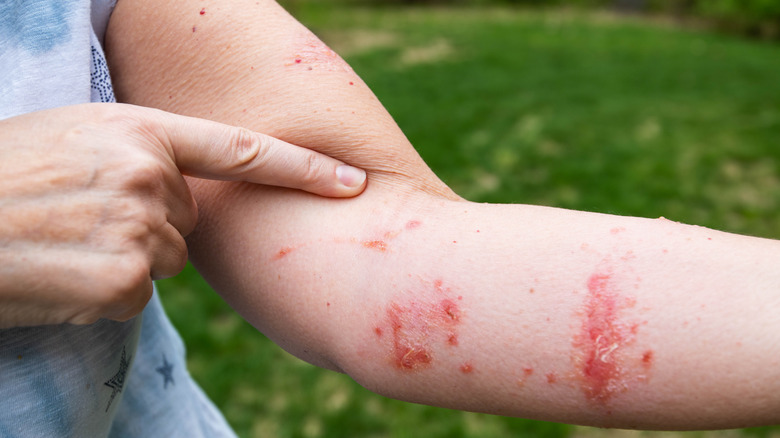Here's How Long Poison Ivy Usually Lasts
A peaceful hike through the woods can take a sudden turn if you find you've come in contact with a certain dreaded three leaf plant. Poison ivy, native to North America, is a toxic plant that can take the form of a tangled vine or shrub growing in heavily wooded areas (via the U.S. Food & Drug Administration). Usually green in color, depending on the time of year, poison ivy can also come in shades of yellow, red, or orange and is sometimes accompanied by small flowers or berries. While this description may paint the picture of a beautiful piece of greenery, this is one plant you don't want to pick.
For humans, physical contact with poison ivy can result in painful itching, inflammation, rash, and blisters on the skin. Why does this reaction occur? Because poison ivy has a component to its leaves that serves as a unique protective mechanism against animals looking for a vegetative snack (via Gardening Know How). This component is an oil known as urushiol, a poisonous toxin that evokes an allergic reaction that can range from relatively mild outcomes to more critical such as hospitalization (Live Science).
According to experts at the Mayo Clinic, a red rash will generally emerge between half a day to two days after contact with the plant or other item contaminated with urushiol oil such as an article of clothing you may have worn or a pet that came along on the hike.
Rashes can last for a few days or as long as three weeks
The rash will usually emerge on the same part of the body that made initial contact with the plant and depending on the manner in which you grazed the leaves, generally takes the form of a straight line (via Live Science). How long the reaction lasts for can vary. Some physicians say you can expect to see it clear up within a few days to a week. Others say the reaction can persist for as long as three weeks (via Mayo Clinic).
Experts stress the most important thing to remember is to refrain from scratching as this can spread the rash to other parts of the body. Preventative measures can help reduce the likelihood of a more severe reaction such as wearing clothes that fully cover areas of the body more prone to plant contact such as the feet or ankles. Additionally, thoroughly washing your hands or your pet immediately after contact with the plant can also lessen the intensity of an allergic reaction along with the use of certain skin creams that work by providing a layer of protection between you and the plant.
Should you develop more severe symptoms such as fever or blisters that become infected with pus, do consult with a medical professional as soon as possible for further treatment instructions.

